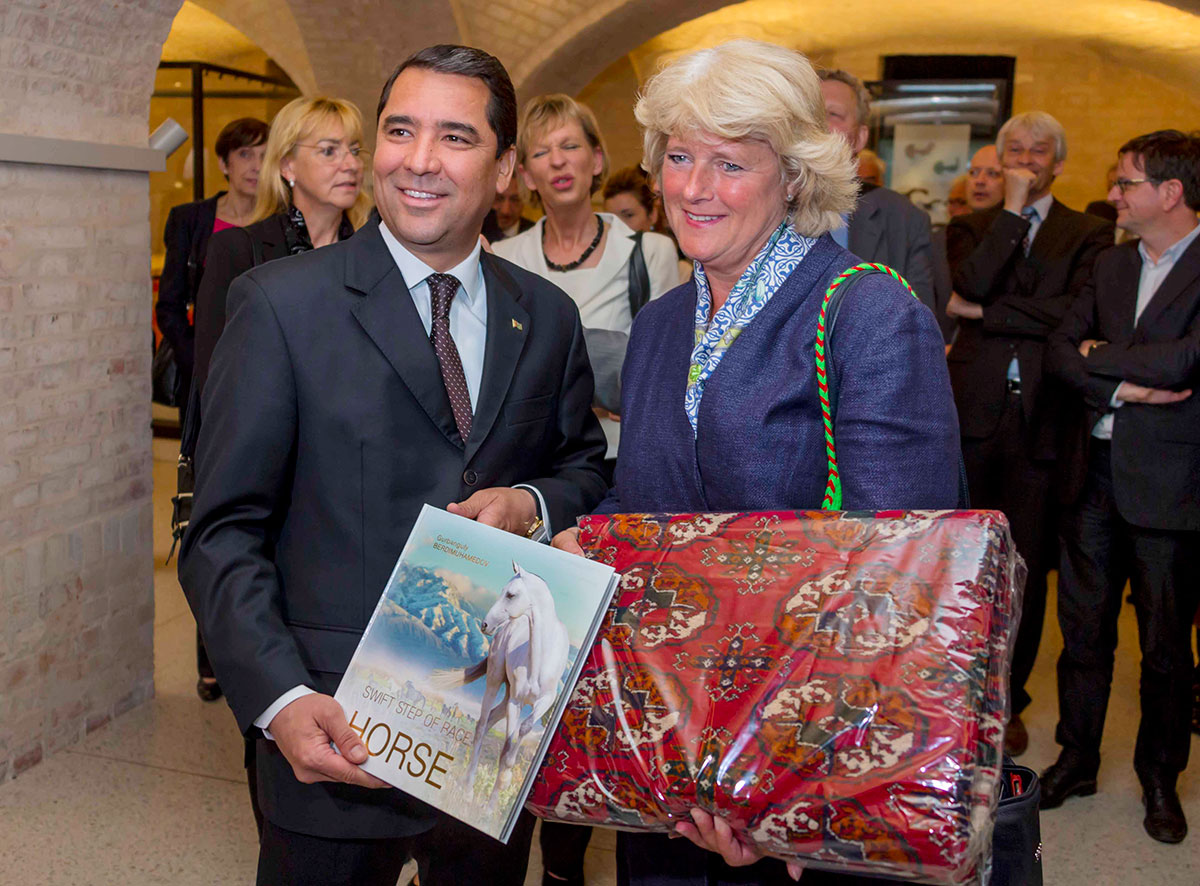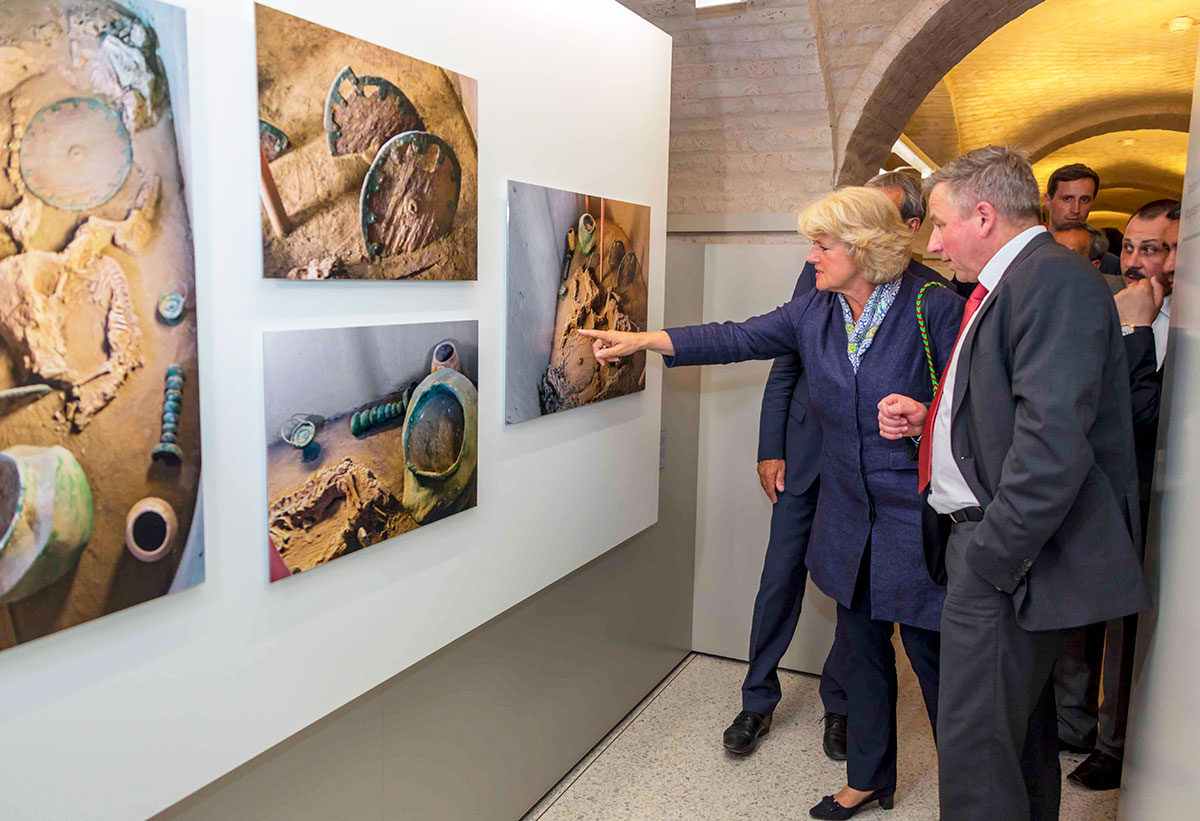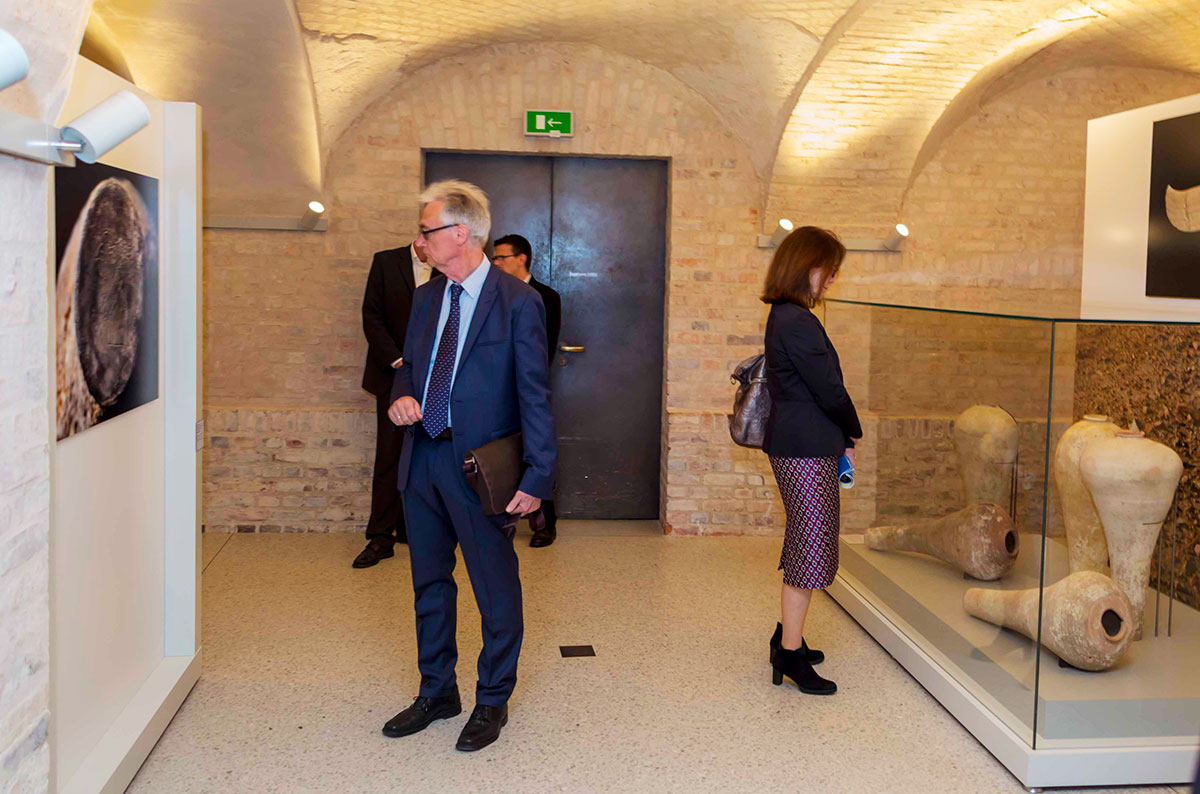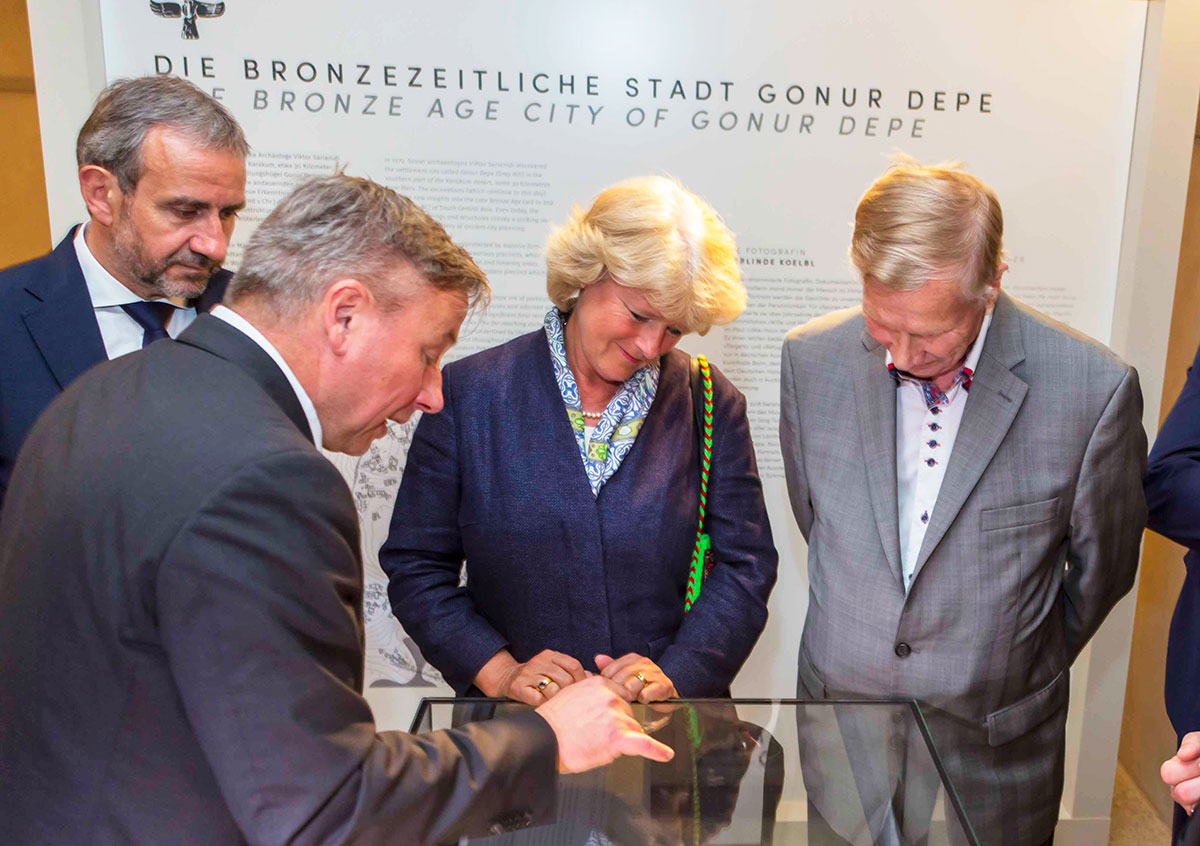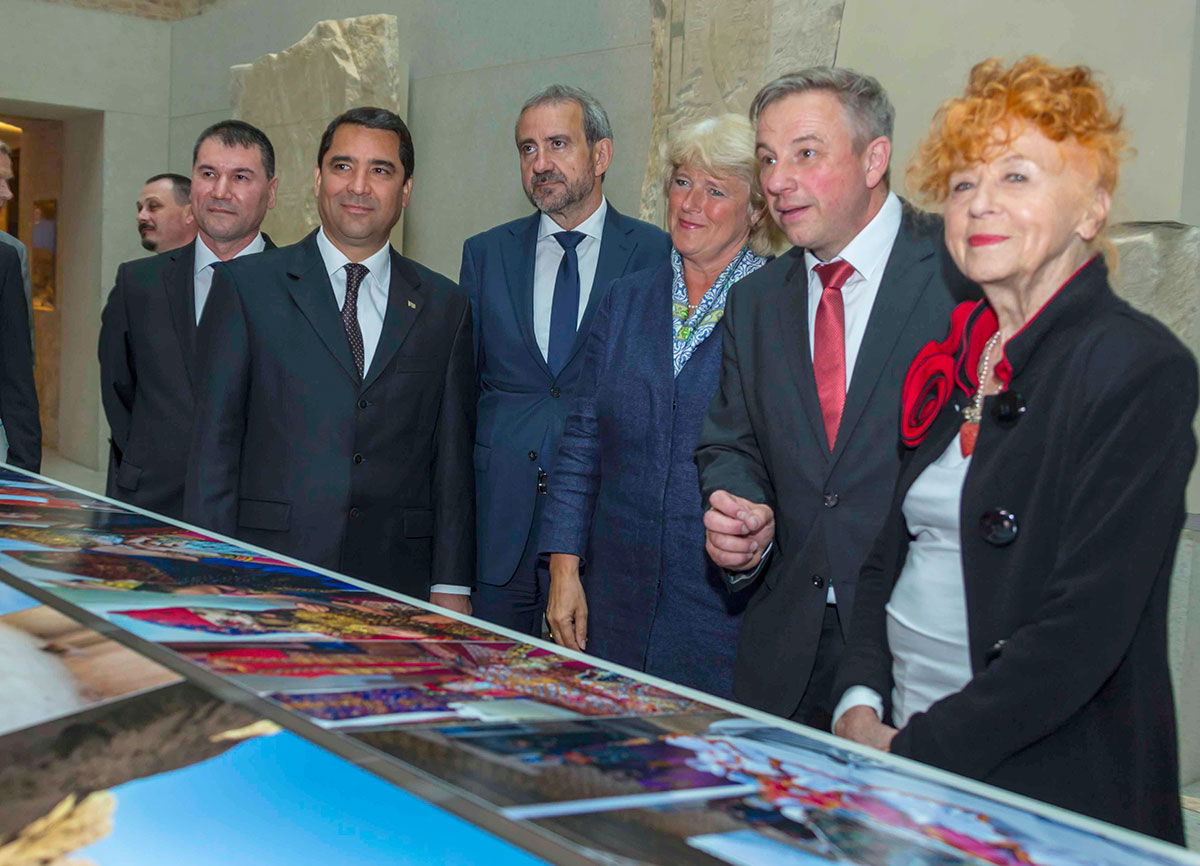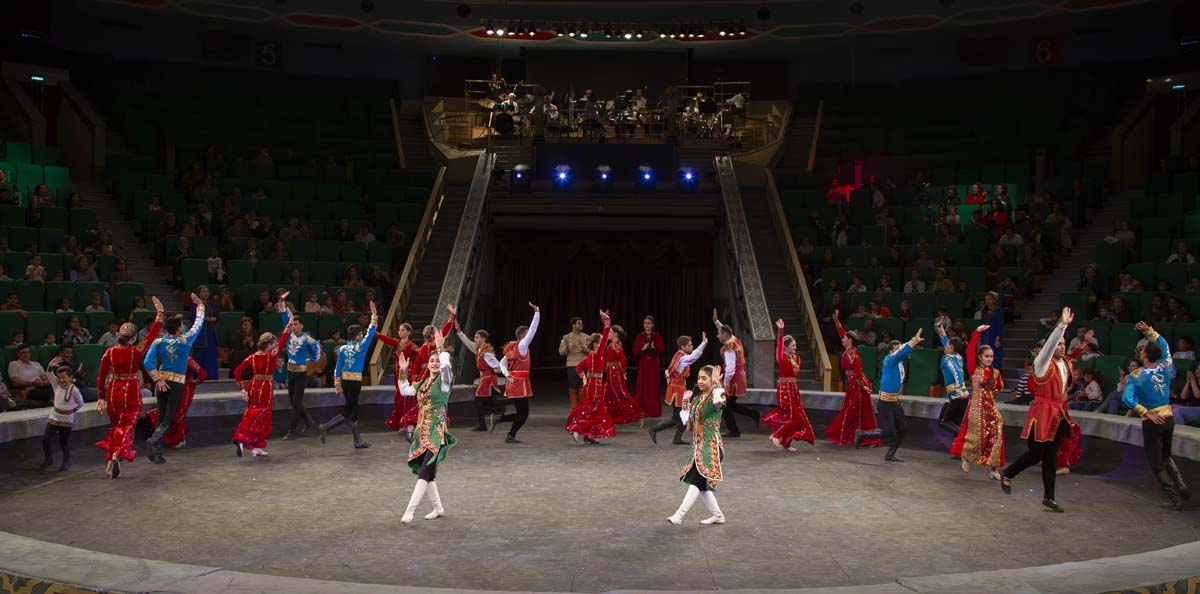Today is the second day of the archaeological exhibition titled Margiana: A Bronze Age Kingdom in Turkmenistan hosted by the Neues Museum of Germany’s capital. Tremendous interest raised in Europe towards the ancient history of our country translated into the exposition launched in this major Museum Center of Germany.
Hundreds of artifacts reflecting the high development level of the civilization that emerged on the Turkmen land approximately four thousand years ago reveal to the Berliners and the city’s guests Turkmenistan’s richest cultural heritage.
Speakers at the opening ceremony warmly recalled Victor Sarianidi who exposed previously unknown Margiana to the world and discovered the majority of artworks and household items of the ancient people. Many threads connect that ancient epoch, that the specialists call the Bronze Age, to modernity. As noted by representatives of the Turkmen and German scientific community, parallels can be drawn between various household items, traditions, rituals and mindset of the ancient inhabitants of Margiana and the multi-millennial history of Turkmenistan.
Since that moment 44 years ago, when this outstanding scientist, together with his Turkmen colleagues, discovered this mysterious country in the sands of the Karakum and began excavations that are continued to the date by his followers, thousands of people were have had a chance to visit the ruins of this previously unknown ancient Oriental kingdom. This pilgrimage has grown over the years as everyone concerned about history wishes to see the picturesque ruins of these legendary places, and primarily, Gonur Depe – the capital of Margiana.
The exhibition in Berlin, a result of fruitful Turkmen–German cooperation in the cultural field, has become a landmark event in making this ancient kingdom accessible to those Europeans who have not yet visited our country and now have a chance to see clear evidence of the high agrarian culture and important role of herding in ancient Turkmenistan.
It has been ascertained by archaeologists that the first people appeared in Margiana in the last centuries of the third millennium BC. For centuries the population of the northern foothills of the Kopetdag Mountains enjoyed sufficient land and water resources, so they explored only the surrounding territories.
However, by the end of the third millennium, the Middle East encountered dry seasons with rapid decline in precipitations, drying rivers, and reducing grain harvests which made it impossible to live there. People had to abandon dry lands, leave their homes and embark on a quest to find the lands with natural environment suitable for farming and herding.
The situation was global in scope and extended from the Mediterranean to the valleys of Indus. Much evidence, archaeological included, has been amassed to prove that it was in the end of the third millennium BC that the dozens of generations ceased to exist in the vast territories of the Ancient East. The time came when the people living in the foothills of the Kopetdag faced acute scarcity of fertile lands and ensuing need to find new ones.
Traveling along the Tejen River, they came down to its delta lost in the sands, reached the Murgab and proceeded downstream, establishing numerous settlements. Perhaps this great migration continued further to the East, reaching the Amu Darya, and the tribes from the Southern Turkmenistan settled on fertile river plains of Bactria with abundant arable land irrigated by waters of turbulent rivers. Numerous archaeological findings in the southern parts of modern Uzbekistan, Tajikistan and in Northern Afghanistan are so similar to those of Margiana that they leave no room for doubt as to the cultural unity of Bactria and Margiana of the Bronze Age.
Palaces and temples were built on the newly inhabited lands, and they were similar to those that archaeologists discovered in Margiana. Wheels were used to make all the finest-quality ceramics that were then burned in furnaces at extremely high temperatures.
The Bronze Age sites at Margiana are primarily smaller settlements whose inhabitants were involved in farming and herding. On the surrounding lands watered by Murgab they grew wheat and barley, millet, lentil, chickpea and pea plants. The gardens yielded abundant harvests of apples, pears, cherry plum, cherry and grapes. Melons were already grown back then.
Wet grasslands with herbal greenery became grazing fields for countless herds of cattle and goats. Camels were used for traction. Privileged inhabitants of Margiana had horses, elite animals that could also be used for riding.
Continued systematic excavations at Gonur reveal new fascinating discoveries every year. There is no evidence as to how this city was called when it flourished. However the findings exposed many important facts about the emergence of the human civilization.
Much of what was found at Gonur Depe was a global discovery. The architecture of the fort and the palace at Gonur that were erected in the late III millennium BC by local builders implies the existence of a persistent and old custom. The ancient fortifications and palace architecture of Margiana, with all its distinctive features and uniqueness, is undeniably part of the building culture of Mesopotamia, Asia Minor and the Mediterranean. Margiana had fire temples, perhaps the earliest among those known to science.
The exhibition in Berlin displays the amazing discoveries from Margiana. They include wall mosaic panels with elements of painting found in nearly all royal tombs in Gonur Depe. Nothing of that kind was ever found at monuments linked to earlier eras or later times. Neither is this technique depicted at monuments in southern parts of Central Asia, or such centers of ancient civilizations as Egypt, Mesopotamia or China. Main walls of all “homes of the dead” in royal tombs of Gonur were decorated with marvelous multi-element compositions, parts of which survived, very fortunately for the archaeologists.
Those were mainly painted patterns, while certain elements contain mosaics. Restorers and other specialists are studying the technique today. Stories behind them and elements depicted on numerous seals and amulets from Margiana and Bactria reflect the common myths of Margiana.
In ancient times, amulets and seals made of stones or metals showcased at the exhibition were believed to have magic powers that had to save the owner from any misfortune. Both sides were often decorated with plain geometric ornaments. Sometimes decorations contained images of both real and fantastic birds, persons and animals in complex narrative compositions.
Cloisonne copper and bronze seals with similar images were as popular as amulets. Decorations on seals often contained eagles with widely spread wings and a proud turn of the head; an ibex; a predaceous lion and a panther; humans, including winged persons, seated on a throne, or riding predators, fighting a couple of snakes or dragons – this list of masterpieces by craftsmen from Margiana who worked four thousand years ago is far from complete.
Many pieces of highest art were found at Gonur. A large cylindrical silver vessel is one of them. It sparked particular interest and admiration among visitors to the exhibition. The vessel has two two-humped camels engraved with much realism. A small tamga-type picture (two brackets and a triangle) placed near the left hip of the animals, and a picture of a camel engraved on the bottom of the vessel receive particular attention . The distinctive feature of this engraving that is seen not only on this item, but also on four other silver vessels from the same storage, is a bow placed above the camels.
The similar engraving is found on the bottom of a big golden pitcher that had no other decoration but this. Such a thorough depiction of two-humped animals both in engraving and graphics reinforces the fact that these items could not have been imported camels did not inhabit territories other than Margiana and Bactria. The animals could be seen and accurately depicted only by those who knew them well. Brushed wool and proud posture of camels highlighted in these and other representations at Gonur speak about their economic value and suggest they were used not only for traction.
Among numerous displays of the exhibition is the round bronze seal whose surface is decorated with four sequentially diverging octagonal stars that strikingly resemble the modern emblem of Turkmenistan.
Certainly, it is impossible to say that octagrams were never encountered as decorative elements. Often they can be seen in cerulean luxury of cladding at medieval mausoleums and mosques. And this motive was known long before the Middle Ages. Small fragments of those seals decorated with octagrams can be found among artifacts from Bactria and Margiana. However this particular seal does not just replicate the ordinary octagon, the geometric figure occupies the whole surface, gradually growing outwards from the center. It is surprising that the land preserved such a wonderful example of art from Margiana.
Skilled stonecutters made different kinds of jewelry (beads, necklaces, cosmetic boxes and vials). Often they were wrapped in finest golden foil, to give the impression of genuinely golden items. Beads were cut from various semi-precious stones: turquoise, carnelian, hematite, lapis lazuli and agate. Quaint combination of colors, forms, use of rigid fastening, pendants – all these testify to the sophisticated taste and high artisanal talent of ancient Turkmen craftsmen.
Another category of items, typical for Bronze Age Bactria and Margiana, that were most likely of ceremonial significance, are composite anthropomorphic statues. They depict sitting people, bodies dressed in loose clothing carved from black steatite, while heads and hands were made of white alabaster, sometimes marble. Along with these statues, ancient ceramists made similar composite statues from soft supple clay and then artfully painted them.
Similar figures were discovered during excavations in Turkmenistan at Gonur Depe. The majority of researchers believe that these are depictions of certain gods. Others suggest that, as they were all found at burials, they are sculptural representations of souls of dead people.
From bones of domestic animals, ancient artisans carved different pins with simple ornaments. Chic pins that women used to style their hair were decorated with different sculptural representations. Findings at monuments of Margiana revealed that four thousand years ago the population of the country shared a common outlook – those were not just detached, stand-alone cults of gods, but a coherent system of views, rituals and ceremonies.
All findings obtained during excavations at different monuments of the ancient land of Margush undeniably indicate that the tribes that inhabited this land practiced rituals, customs and traditions that later evolved into Zoroastrian. For approximately two hundred years now, scientists from all over the world have been searching for the birthplace of the first world religion, Zoroastrianism. However archaeological materials from Margiana reveal that no any other place in the Ancient East contained such a variety of actual facts that would link the customs and traditions of the population of the country with the Zoroastrian religion that followed.
Hundreds of artifacts reflecting the high development level of the civilization that emerged on the Turkmen land approximately four thousand years ago reveal to the Berliners and the city’s guests Turkmenistan’s richest cultural heritage.
Speakers at the opening ceremony warmly recalled Victor Sarianidi who exposed previously unknown Margiana to the world and discovered the majority of artworks and household items of the ancient people. Many threads connect that ancient epoch, that the specialists call the Bronze Age, to modernity. As noted by representatives of the Turkmen and German scientific community, parallels can be drawn between various household items, traditions, rituals and mindset of the ancient inhabitants of Margiana and the multi-millennial history of Turkmenistan.
Since that moment 44 years ago, when this outstanding scientist, together with his Turkmen colleagues, discovered this mysterious country in the sands of the Karakum and began excavations that are continued to the date by his followers, thousands of people were have had a chance to visit the ruins of this previously unknown ancient Oriental kingdom. This pilgrimage has grown over the years as everyone concerned about history wishes to see the picturesque ruins of these legendary places, and primarily, Gonur Depe – the capital of Margiana.
The exhibition in Berlin, a result of fruitful Turkmen–German cooperation in the cultural field, has become a landmark event in making this ancient kingdom accessible to those Europeans who have not yet visited our country and now have a chance to see clear evidence of the high agrarian culture and important role of herding in ancient Turkmenistan.
It has been ascertained by archaeologists that the first people appeared in Margiana in the last centuries of the third millennium BC. For centuries the population of the northern foothills of the Kopetdag Mountains enjoyed sufficient land and water resources, so they explored only the surrounding territories.
However, by the end of the third millennium, the Middle East encountered dry seasons with rapid decline in precipitations, drying rivers, and reducing grain harvests which made it impossible to live there. People had to abandon dry lands, leave their homes and embark on a quest to find the lands with natural environment suitable for farming and herding.
The situation was global in scope and extended from the Mediterranean to the valleys of Indus. Much evidence, archaeological included, has been amassed to prove that it was in the end of the third millennium BC that the dozens of generations ceased to exist in the vast territories of the Ancient East. The time came when the people living in the foothills of the Kopetdag faced acute scarcity of fertile lands and ensuing need to find new ones.
Traveling along the Tejen River, they came down to its delta lost in the sands, reached the Murgab and proceeded downstream, establishing numerous settlements. Perhaps this great migration continued further to the East, reaching the Amu Darya, and the tribes from the Southern Turkmenistan settled on fertile river plains of Bactria with abundant arable land irrigated by waters of turbulent rivers. Numerous archaeological findings in the southern parts of modern Uzbekistan, Tajikistan and in Northern Afghanistan are so similar to those of Margiana that they leave no room for doubt as to the cultural unity of Bactria and Margiana of the Bronze Age.
Palaces and temples were built on the newly inhabited lands, and they were similar to those that archaeologists discovered in Margiana. Wheels were used to make all the finest-quality ceramics that were then burned in furnaces at extremely high temperatures.
The Bronze Age sites at Margiana are primarily smaller settlements whose inhabitants were involved in farming and herding. On the surrounding lands watered by Murgab they grew wheat and barley, millet, lentil, chickpea and pea plants. The gardens yielded abundant harvests of apples, pears, cherry plum, cherry and grapes. Melons were already grown back then.
Wet grasslands with herbal greenery became grazing fields for countless herds of cattle and goats. Camels were used for traction. Privileged inhabitants of Margiana had horses, elite animals that could also be used for riding.
Continued systematic excavations at Gonur reveal new fascinating discoveries every year. There is no evidence as to how this city was called when it flourished. However the findings exposed many important facts about the emergence of the human civilization.
Much of what was found at Gonur Depe was a global discovery. The architecture of the fort and the palace at Gonur that were erected in the late III millennium BC by local builders implies the existence of a persistent and old custom. The ancient fortifications and palace architecture of Margiana, with all its distinctive features and uniqueness, is undeniably part of the building culture of Mesopotamia, Asia Minor and the Mediterranean. Margiana had fire temples, perhaps the earliest among those known to science.
The exhibition in Berlin displays the amazing discoveries from Margiana. They include wall mosaic panels with elements of painting found in nearly all royal tombs in Gonur Depe. Nothing of that kind was ever found at monuments linked to earlier eras or later times. Neither is this technique depicted at monuments in southern parts of Central Asia, or such centers of ancient civilizations as Egypt, Mesopotamia or China. Main walls of all “homes of the dead” in royal tombs of Gonur were decorated with marvelous multi-element compositions, parts of which survived, very fortunately for the archaeologists.
Those were mainly painted patterns, while certain elements contain mosaics. Restorers and other specialists are studying the technique today. Stories behind them and elements depicted on numerous seals and amulets from Margiana and Bactria reflect the common myths of Margiana.
In ancient times, amulets and seals made of stones or metals showcased at the exhibition were believed to have magic powers that had to save the owner from any misfortune. Both sides were often decorated with plain geometric ornaments. Sometimes decorations contained images of both real and fantastic birds, persons and animals in complex narrative compositions.
Cloisonne copper and bronze seals with similar images were as popular as amulets. Decorations on seals often contained eagles with widely spread wings and a proud turn of the head; an ibex; a predaceous lion and a panther; humans, including winged persons, seated on a throne, or riding predators, fighting a couple of snakes or dragons – this list of masterpieces by craftsmen from Margiana who worked four thousand years ago is far from complete.
Many pieces of highest art were found at Gonur. A large cylindrical silver vessel is one of them. It sparked particular interest and admiration among visitors to the exhibition. The vessel has two two-humped camels engraved with much realism. A small tamga-type picture (two brackets and a triangle) placed near the left hip of the animals, and a picture of a camel engraved on the bottom of the vessel receive particular attention . The distinctive feature of this engraving that is seen not only on this item, but also on four other silver vessels from the same storage, is a bow placed above the camels.
The similar engraving is found on the bottom of a big golden pitcher that had no other decoration but this. Such a thorough depiction of two-humped animals both in engraving and graphics reinforces the fact that these items could not have been imported camels did not inhabit territories other than Margiana and Bactria. The animals could be seen and accurately depicted only by those who knew them well. Brushed wool and proud posture of camels highlighted in these and other representations at Gonur speak about their economic value and suggest they were used not only for traction.
Among numerous displays of the exhibition is the round bronze seal whose surface is decorated with four sequentially diverging octagonal stars that strikingly resemble the modern emblem of Turkmenistan.
Certainly, it is impossible to say that octagrams were never encountered as decorative elements. Often they can be seen in cerulean luxury of cladding at medieval mausoleums and mosques. And this motive was known long before the Middle Ages. Small fragments of those seals decorated with octagrams can be found among artifacts from Bactria and Margiana. However this particular seal does not just replicate the ordinary octagon, the geometric figure occupies the whole surface, gradually growing outwards from the center. It is surprising that the land preserved such a wonderful example of art from Margiana.
Skilled stonecutters made different kinds of jewelry (beads, necklaces, cosmetic boxes and vials). Often they were wrapped in finest golden foil, to give the impression of genuinely golden items. Beads were cut from various semi-precious stones: turquoise, carnelian, hematite, lapis lazuli and agate. Quaint combination of colors, forms, use of rigid fastening, pendants – all these testify to the sophisticated taste and high artisanal talent of ancient Turkmen craftsmen.
Another category of items, typical for Bronze Age Bactria and Margiana, that were most likely of ceremonial significance, are composite anthropomorphic statues. They depict sitting people, bodies dressed in loose clothing carved from black steatite, while heads and hands were made of white alabaster, sometimes marble. Along with these statues, ancient ceramists made similar composite statues from soft supple clay and then artfully painted them.
Similar figures were discovered during excavations in Turkmenistan at Gonur Depe. The majority of researchers believe that these are depictions of certain gods. Others suggest that, as they were all found at burials, they are sculptural representations of souls of dead people.
From bones of domestic animals, ancient artisans carved different pins with simple ornaments. Chic pins that women used to style their hair were decorated with different sculptural representations. Findings at monuments of Margiana revealed that four thousand years ago the population of the country shared a common outlook – those were not just detached, stand-alone cults of gods, but a coherent system of views, rituals and ceremonies.
All findings obtained during excavations at different monuments of the ancient land of Margush undeniably indicate that the tribes that inhabited this land practiced rituals, customs and traditions that later evolved into Zoroastrian. For approximately two hundred years now, scientists from all over the world have been searching for the birthplace of the first world religion, Zoroastrianism. However archaeological materials from Margiana reveal that no any other place in the Ancient East contained such a variety of actual facts that would link the customs and traditions of the population of the country with the Zoroastrian religion that followed.




